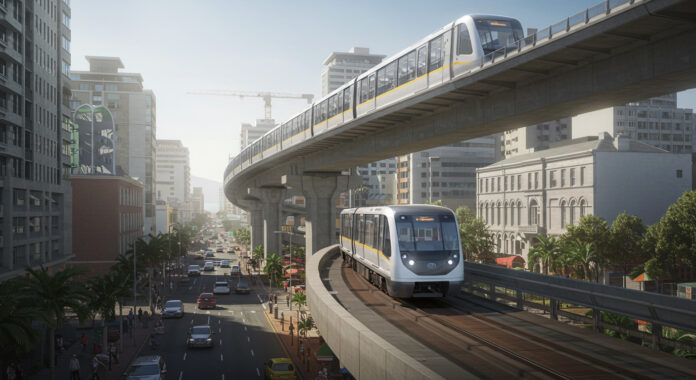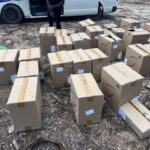Cape Town – A South African development engineer, Gareth Ramsay, is championing a proposal to introduce a "sky train" system to Cape Town, arguing it would alleviate traffic congestion, modernise public transport, and make better use of underutilised infrastructure. However, the City of Cape Town has seemingly put the brakes on Ramsay's vision, deeming it financially unviable.
Ramsay's plan envisions a modern elevated rail system running from the Cape Town CBD towards the Atlantic seaboard, potentially integrating with the city’s infamous unfinished Foreshore Freeway Bridge. He believes this project would significantly improve mobility in one of the city's most congested areas and serve as a high-capacity, future-proof alternative to current public transport solutions.
According to Ramsay, this project would improve mobility in one of the city’s most congested areas and could serve as a high-capacity, future-proof alternative to current public transport solutions.
Rob Quintas, the city’s mayoral committee member for urban mobility, confirmed that the elevated railway idea is not under consideration. While the city is conducting a scoping study on the broader Foreshore Freeway Precinct to explore long-term transport and land use solutions, Quintas stated that a sky train simply isn’t financially viable.
“The infrastructure, rolling stock, and ongoing operations of a modern elevated railway would be prohibitively expensive when weighed against the city’s budget constraints,” he said. Additionally, Quintas pointed out that international experience shows such systems typically require continuous subsidies to remain operational.
Cape Town has already committed significant resources to its MyCiti bus service, which Quintas sees as a more practical and cost-effective investment. The MyCiti network runs throughout the CBD and surrounding suburbs like Green Point and Sea Point, and the city believes that improving this service is a better use of funds than building an entirely new transport system.
Ramsay, however, has challenged the city’s stance, particularly its dismissal of the sky train without what he sees as a meaningful review. He told TopAuto that the city’s statement that the train system is “not a consideration” suggests that it has not received serious scrutiny or formal evaluation. He is not opposed to the city rejecting the project if deemed unviable, but he takes issue with the apparent lack of investigation or feedback since the proposal was submitted.
Ramsay acknowledged the city’s support for expanding the MyCiti network as a viable long-term solution. However, he pointed out that the physical limitations of the city’s road infrastructure, particularly in densely populated areas like Sea Point and Green Point, limit the potential capacity for the bus system. He noted that narrow roads, limited space for dedicated bus lanes, and the buses’ large turning circles all reduce their efficiency.
In many parts of the city, MyCiti buses are caught in the same congestion as private vehicles, undermining their appeal as a public transport alternative.
Ramsay further pointed out that future urban development, such as the mixed-use plans for the Three Anchor Bay site, will increase population density in key areas, adding even more pressure to already saturated road networks. He also highlighted the limitations of the MyCiti system during peak periods or after major events.
A sky train, by contrast, could move that same number of passengers within two minutes, providing a far more efficient solution. While he acknowledged that the sky train would involve substantial upfront costs, he argued that its long-term cost-efficiency and transport benefits outweigh the initial investment. “The question is increasingly becoming less and less of whether or not we can afford it, but rather whether we can afford not to,” he said.
Citing an older estimate, Ramsay noted that completing the Foreshore Freeway would cost over R2.1 billion without meaningfully improving congestion. He added that roads are vulnerable to traffic accidents that can shut down areas for hours, while a rail system avoids such delays. He also suggested that the sale of the Three Anchor Bay site, potentially worth R700 million, could help fund the initial phases of the rail project.
Ramsay rejected the argument that elevated rail systems should be dismissed because of their reliance on subsidies. He said the economic and social returns, such as increased productivity, reduced commuting times, and improved commuter well-being, typically justify the public investment.
“It is hypocritical to claim that extending a rail system is not viable due to subsidies, especially when the MyCiti Bus service benefits from national government subsidies,” he said. “This support is justified, given the positive impact the service has on citizens’ lives and the Cape Town economy.”
He also pointed out that bus services are vulnerable to fuel price volatility, which ultimately affects commuters. Electric-powered rail systems, he argued, offer greater long-term economic and environmental stability.
Ramsay believes the sky train could be a transformative transport project for Cape Town, which could alleviate traffic and improve urban development and economic growth. The debate over the sky train highlights the ongoing challenges of addressing traffic congestion and improving public transport in South Africa's major cities. While the City of Cape Town remains committed to its MyCiti bus service, Ramsay's proposal raises important questions about the potential of more ambitious and innovative transport solutions.

Follow Us on Twitter










